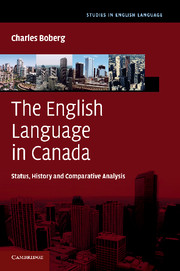Book contents
- Frontmatter
- Contents
- List of figures
- List of tables
- Acknowledgments
- Maps 1-3
- 1 English in the Canadian context
- 2 The establishment and growth of Canada's English-speaking population
- 3 The principal features of Canadian English in comparative perspective
- 4 Variation and change in the vocabulary of Canadian English
- 5 Variation and change in the phonetics of Canadian English
- 6 Summary and future directions
- References
- Index
3 - The principal features of Canadian English in comparative perspective
Published online by Cambridge University Press: 05 August 2011
- Frontmatter
- Contents
- List of figures
- List of tables
- Acknowledgments
- Maps 1-3
- 1 English in the Canadian context
- 2 The establishment and growth of Canada's English-speaking population
- 3 The principal features of Canadian English in comparative perspective
- 4 Variation and change in the vocabulary of Canadian English
- 5 Variation and change in the phonetics of Canadian English
- 6 Summary and future directions
- References
- Index
Summary
Few people would question the assertion that there are now two widely recognized standard varieties of English in the world: British and American (Trudgill and Hannah 1985: 1–3). This duality arose from the political separation of the United States from Britain in the eighteenth century, together with the barrier to communication presented by the Atlantic Ocean, in an age before jet travel, satellite beams and the internet. Over four centuries, these factors have produced a substantial set of differences between the types of English spoken in Britain and America, aside from the variation found within each of them. Some of these national differences are older forms preserved in American English that have been altered or abandoned in later stages of British English; others are innovations in American English that never spread to Britain. Whatever their origin, these differences led Noah Webster to publish an American Dictionary of the English Language as early as 1812 and John Russell Bartlett to produce a Dictionary of Americanisms in 1849. In 1919, H. L. Mencken published the first edition of his encyclopedic study of American English, which he significantly called The American Language, emphasizing its distinctness from the “language” of Britain. In 1944, John S. Kenyon and Thomas A. Knott put forth a Pronouncing Dictionary of American English, which became the standard account of American English pronunciation. Together, these works and others acknowledge that British and American English are different enough to justify separate lexicographic traditions and different standards of usage.
- Type
- Chapter
- Information
- The English Language in CanadaStatus, History and Comparative Analysis, pp. 106 - 166Publisher: Cambridge University PressPrint publication year: 2010



